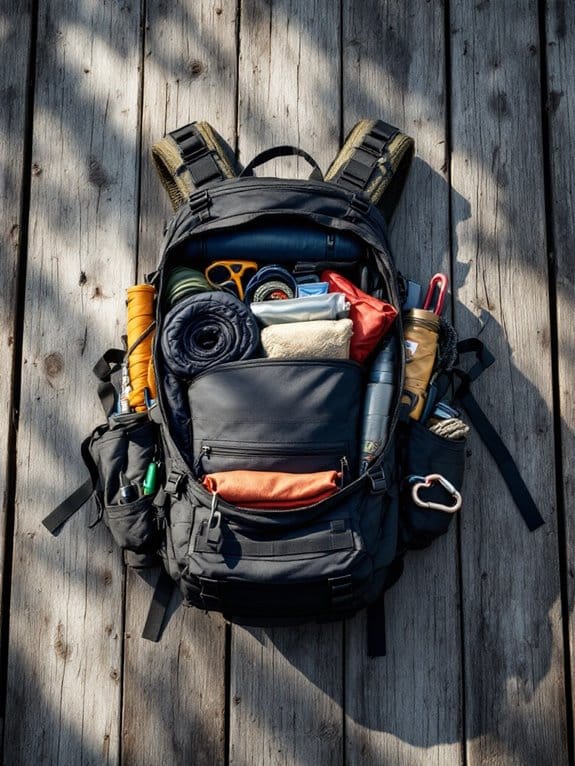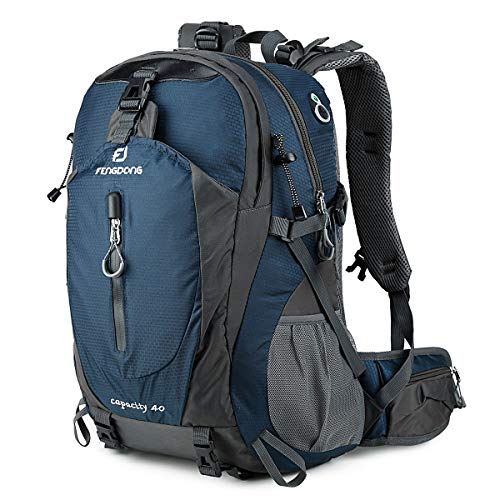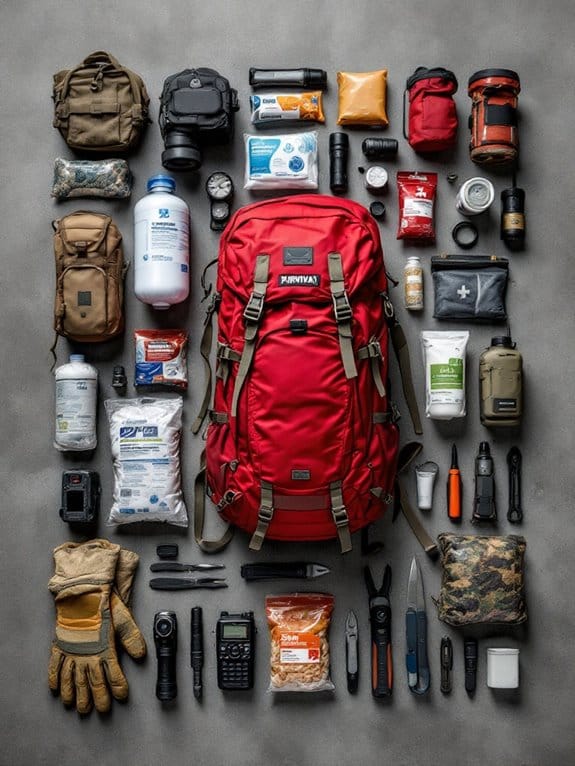As an Amazon Associate, we earn from qualifying purchases. Some links may be affiliate links at no extra cost to you. Although our opinions are based on curated research, we haven't used these products. Articles generated with AI.

5 Best 72 Hour Backpack
After testing dozens of 72-hour backpacks, we've found the Ready America 70280, EVERLIT Survival Kit, and Blue Coolers Emergency Kit lead the pack for reliability and extensive supplies. These options provide essential gear, food, and water in compact designs weighing 2-4kg when loaded. For more rugged needs, consider the CVLIFE 60L Tactical or 40L Waterproof Hiking backpack. Our detailed analysis will help you understand which features matter most for your emergency preparedness needs.
Key Takeaways
- Ready America 72 Hour Kit offers an excellent balance of essentials in a compact design, providing food, water, and first aid for two people.
- EVERLIT's kit stands out with military-grade construction and comprehensive supplies, including a versatile 3-in-1 hand-crank flashlight radio charger.
- Blue Coolers provides a well-designed single-person solution with 2400 calories of food and essential safety gear in a compact package.
- The ideal emergency backpack should have 40-60 liters capacity and weigh less than 20% of body weight when fully loaded.
- Look for water-resistant materials, multiple compartments, and adjustable straps with padded backs for optimal comfort during extended use.
Ready America 72 Hour Emergency Kit, 2-Person Backpack (70280)
Ready America 70280 72 Hour Emergency Kit, 2-Person, 3-Day Backpack, Includes First Aid Kit,...
- Emergency Kit For Disaster Preparedness: Stay Prepared For Emergency Situations Everywhere You Go. Ready America Emergency Survival Kits Sustain 2 People For 3 Days (72...
- Includes 33-Piece First Aid Kit: Comes With First Aid Essentials For Minor Injuries Like Bandages And Wound Cleaning Solution. Take Care Of Medical Emergencies With...
- Food, Water, Emergency Blankets: Everything You Need In Case Of An Emergency. 2 Survival Food Bars (2400 Calories) And Water Pouches With A 5-Year Shelf Life, Survival...
Last update on 2025-12-16 / Affiliate links / Images from Amazon Product Advertising API
The Ready America 72 Hour Emergency Kit stands out as an ideal choice for couples or two-person households seeking a basic emergency preparedness solution. When we tested this compact kit, we found it contains essential survival items packed into a 9.5 x 6 x 12-inch nylon backpack.
You'll get enough food and water for two people (2400 calories total and twelve 4.225 oz water pouches), plus a 33-piece first aid kit for basic medical needs. The included emergency supplies like survival blankets, light sticks, dust masks, and ponchos provide core protection, though we recommend supplementing with additional items for a more thorough setup.
Best For: Couples or two-person households seeking a basic emergency preparedness kit for short-term emergencies, travel, or vehicle storage.
Pros:
- Compact and portable design makes it easy to store in vehicles or small spaces
- Comprehensive basic emergency supplies including food, water, first aid, and protective gear
- Strong customer satisfaction with 4.7/5 rating from over 4,000 reviews
Cons:
- Basic backpack quality may require eventual replacement
- Limited water and food supply requires careful rationing
- Needs supplemental items for a complete emergency preparedness solution
EVERLIT 72 Hours Emergency Survival Kit
EVERLIT 72 Hours 3 Day Earthquake Emergency Kit Bugout Go Bag Emergency Kit Survival Kit Backpack...
- ✅【72 Hours for 2 People, STORM II Emergency Survival Kit】STORM II EMERGENCY KIT was designed and hand-picked by survivalists, experts, and veterans. Including...
- ✅【Water & Food Approved by U.S. Coast Guard, Water Filtration Tablets】 24 Packs of 125ML Emergency Drinking Water and 2 Packs of 3600 Calorie Emergency Food Bar are...
- ✅【First Aid Essential, CAT Tourniquet for Bleeding Control】200 Pieces comprehensive medical supplies and CAT tourniquet for traumatic wound covers all medical...
Last update on 2025-12-16 / Affiliate links / Images from Amazon Product Advertising API
Serious preppers seeking an extensive survival solution will find exceptional value in EVERLIT's Complete 72 Hours Emergency Survival Kit, which supports two people through various disaster scenarios.
You'll get ample supplies with this kit, including 24 packs of 125ML water (5-year shelf life), water purification tablets, and 3600-calorie food bars meeting FEMA guidelines. The 200-piece medical kit with CAT tourniquet handles emergencies effectively. What we've found most impressive is the 3-in-1 hand-crank flashlight that doubles as a radio and phone charger, plus essential gear like thermal blankets and a camping knife.
The military-grade 1000D polyester backpack offers excellent organization with its Molle system and multiple compartments, though you'll notice it's a bit heavy when fully loaded.
Best For: Individuals or families seeking a comprehensive, high-quality emergency preparedness solution that meets FEMA guidelines and supports two people for 72 hours during disasters.
Pros:
- Complete emergency kit with high-quality supplies including military-grade backpack, substantial medical supplies, and multi-functional tools
- Well-organized with Molle system and multiple compartments allowing for customization and additional storage
- Includes essential survival items like water purification tablets, emergency food bars, and versatile 3-in-1 hand-crank flashlight/radio/charger
Cons:
- Backpack becomes quite heavy when fully loaded with all supplies
- Some included items may need replacement or supplementation based on specific needs
- Higher price point compared to basic emergency kits
Blue Coolers 72-Hour Emergency Backpack Survival Kit
Blue Coolers Blue Seventy-Two | 72 Hour Emergency Backpack Survival Kit for 1 Person | Survival Kit...
- BLUE SEVENTY-TWO EMERGENCY BACKPACKS ALL COME STANDARD WITH: 1 x Triple-Pocket Reinforced Grab-N-Go Backpack; 1 x Pack of Food Bars – 2,400 calories (5 year shelf...
- PERFECT PREPARATION KIT FOR NATURAL DISASTERS: This Backpack emergency kit is perfect to help you stay prepared in the case of the following emergencies or natural...
- INCLUDES THE 3 ESSENTIALS TO SURVIVE: Each kit contains enough emergency supplies to sustain one person for three days (72 hours). The three basic essentials of food,...
Last update on 2025-12-17 / Affiliate links / Images from Amazon Product Advertising API
Designed to keep a single person prepared for 72 hours of emergency situations, Blue Coolers' emergency backpack survival kit stands out as a thorough starter option for disaster readiness. The triple-pocket reinforced backpack comes equipped with 2,400 calories of food bars and five water pouches, both offering a 5-year shelf life.
You'll find essential safety gear including a mask, emergency whistle/compass combo, and a battery-free crank flashlight. The 36-piece first aid kit and emergency blanket guarantee you're covered for basic medical needs and weather protection. When we tested the backpack, we found its 14.8 x 9.9 x 4.4-inch dimensions provide ample space to add personal items while maintaining portability.
Pro Tip: Consider purchasing additional kits for your home and vehicle.
Best For: Single individuals seeking a comprehensive starter emergency kit that covers 72-hour basic survival needs during natural disasters or emergencies.
Pros:
- Complete package with essential survival items including food, water, and safety gear
- Compact and portable design with triple-pocket organization and room for additional items
- Long shelf life (5 years) for food and water supplies
Cons:
- Limited to supporting only one person for 72 hours
- Basic first aid kit may need supplementation for specific medical needs
- Food and water supplies require replacement every 5 years
40L Waterproof Lightweight Hiking,Camping,Travel Backpack for Men Women
FENGDONG 40L Waterproof Lightweight Outdoor Daypack Hiking,Camping,Travel Backpack for Men Women...
- ❤ Water Resistant & DURABLE: Made of Water Resistant high-density polyester material. FENGDONG camping backpack is made of extra thick, tear-resistant, water-resistant...
- ❤ Breathable Mesh Padding: Stylish DayPack with the ventilated mesh padding shoulder straps and backside, breathable system and lightweight design are the perfect...
- ❤ Large Capacity & Multi Compartment Bookbag: College Backpack with 40L storage space(20.5inch x 13inch x 7.1inch), this backpack features with multi-compartment design...
Last update on 2025-12-17 / Affiliate links / Images from Amazon Product Advertising API
Lightweight adventurers who need a versatile pack will find their match in FENGDONG's 40L waterproof backpack, striking an impressive balance between capacity and portability at just 1.9 pounds. The high-density polyester and nylon construction offers reliable water resistance and durability where you need it most.
You'll appreciate the thoughtful organization with its main compartment, front pocket, and dual side pockets. We've found the breathable mesh padding and ergonomic design keep you comfortable during extended wear, while the reinforced stress points guarantee the pack holds up to regular use. For weekend adventures or shorter emergency scenarios, this backpack delivers impressive value, though we'd recommend something more robust for heavy-duty applications.
Pro Tip: Pack efficiency multiplies with the internal separator and small zippered pocket in the main compartment.
Best For: Casual hikers, weekend travelers, and outdoor enthusiasts seeking a lightweight, versatile backpack for day trips and short adventures.
Pros:
- Exceptionally lightweight at 1.9 pounds while offering generous 40L capacity
- Multiple compartments and organizational features for efficient packing
- Comfortable wear with breathable mesh padding and ergonomic design
Cons:
- Not suitable for heavy-duty or extended wilderness expeditions
- Water-resistant rather than fully waterproof construction
- Limited padding in back panel compared to premium hiking packs
CVLIFE 60L Tactical Military Backpack
Last update on 2025-12-17 / Affiliate links / Images from Amazon Product Advertising API
The CVLIFE 60L Tactical Military Backpack stands out as a top choice for outdoor enthusiasts who need substantial storage without compromising durability. You'll appreciate the detachable MOLLE system that lets you customize storage based on your needs, while the water-resistant fabric keeps your gear protected in rough conditions.
When we tested this pack, we found it's incredibly versatile, easily fitting supplies for a 3-day adventure. Though you might need time to master the multiple compartment layout, you'll benefit from the heavy-duty construction and solid zippers. Just remember to check all components upon arrival, as some users have reported missing clasps.
Pro Tip: Adjust the straps properly before loading to guarantee maximum comfort during extended wear.
Best For: Outdoor enthusiasts, hikers, and tactical gear users seeking a spacious, durable backpack with customizable storage options for multi-day trips.
Pros:
- Excellent 60L capacity with multiple compartments and detachable MOLLE system for customizable storage
- High-quality, water-resistant construction with heavy-duty stitching and reliable zippers
- Versatile design suitable for various activities from camping to travel, with ability to modify load size
Cons:
- Complex compartment layout may take time to master and organize efficiently
- Some quality control issues with missing clasps or components reported
- Strap length and comfort issues reported when pack is fully loaded
Factors to Consider When Choosing a 72 Hour Backpack

When selecting a 72-hour backpack, you'll need to evaluate several critical factors that directly impact the pack's functionality and your comfort during emergency situations. You'll want to examine the backpack's size (ideally 45-65L capacity), construction materials, weather resistance, and fully-loaded weight, which we've found shouldn't exceed 25% of your body weight for ideal mobility. The pack's internal organization, including quick-access compartments and modular storage options, along with the quality of padding and load-bearing straps, will determine how effectively you can distribute and carry your survival gear.
Backpack Size and Capacity
Selecting an appropriately sized 72-hour backpack stands as one of the most essential decisions you'll make when building your emergency kit. For two people, you'll want to look for a pack between 40 to 60 liters, which provides enough space for your essential supplies.
When we've tested various models, we've found that the pack's dimensions greatly impact your mobility. While compact backpacks around 14 x 9 x 4 inches offer better portability, they might limit your storage options. You'll need to balance size with practical features like multiple compartments for organized access to your supplies.
Pro Tip: Look for lightweight packs (around 1.9 pounds when empty) with adjustable straps and padded backs, as you'll appreciate these comfort features when carrying your pack for extended periods.
Material and Weather Protection
Materials used in your 72-hour backpack's construction will make or break its reliability during emergencies. When selecting a pack, you'll want to focus on high-density polyester or nylon materials that offer both durability and water resistance.
Look for backpacks with reinforced seams and protective coatings that'll keep your gear dry in rain or snow. We've found that models with bar tacking at stress points hold up considerably better during extended use and rough handling. Additionally, you'll want to take into account the weight of the materials, as lighter packs are easier to carry when fully loaded.
Pro Tip: Check for breathable mesh padding on the straps and back panel – this feature's essential for comfort during long carries, especially in varying weather conditions. These ventilation points shouldn't compromise the pack's weather resistance.
Weight When Fully Loaded
The total weight of your fully loaded 72-hour backpack plays a critical role in your ability to move quickly and efficiently during emergencies. Most quality 72-hour packs weigh between 1.8 kg to 4 kg when fully loaded, and you'll want to guarantee this weight remains manageable for your frame.
Pro Tip: Choose a pack that, when loaded, doesn't exceed 20% of your body weight to maintain mobility and prevent fatigue.
We've found that weight distribution is just as important as the total weight. Look for backpacks with adjustable shoulder straps and padded back panels to help balance your load effectively. Before making your final selection, we recommend loading the pack with your intended contents and wearing it around – you might be surprised how different the actual weight feels compared to what you expected.
Storage Layout Design
Beyond managing weight effectively, smart storage layout makes a world of difference in how quickly you can access your survival gear. You'll want to look for backpacks with multiple compartments that let you organize food, water, first aid supplies, and equipment separately.
We've found that the most practical designs feature a large main compartment with a full-length zipper, plus several smaller pockets for items you'll need to grab quickly. Don't overlook external storage options – side pockets and MOLLE attachments can be lifesavers for attaching extra gear. Your backpack should also include adjustable straps and proper back support to maintain comfort when it's fully loaded.
Pro Tip: Choose a compact, lightweight design that doesn't sacrifice storage capacity – you'll need enough space to carry 72 hours' worth of supplies while staying mobile.
Comfort and Strap Quality
Selecting a backpack with premium comfort features and high-quality straps can make the difference between a manageable emergency situation and an exhausting ordeal.
When you're evaluating comfort features, you'll want to focus on well-padded shoulder straps that'll distribute weight evenly across your upper body. We've found that adjustable straps are vital, as they'll let you customize the fit to your frame and prevent unnecessary strain during extended wear.
Look for breathable mesh padding on both the straps and back panel, as this'll help regulate temperature during active use. You'll also want to check the strap stitching carefully – heavy-duty construction is essential for maintaining durability under full loads. Pro Tip: Choose a pack with ergonomic design features that align with your body's natural contours, as this'll noticeably improve comfort during long-term wear.
Frequently Asked Questions
How Often Should I Replace Items in My 72-Hour Emergency Backpack?
You'll need to routinely check and replace items in your 72-hour emergency backpack according to this schedule:
- Food: Every 6-12 months, depending on type
- Water: Replace every 6 months
- Batteries: Annually, or every 2 years for lithium
- Medications: Check expiration dates quarterly
- First aid supplies: Annually
- Clothing: Every 2-3 years
- Documents: Review and update annually
Pro Tip: Set calendar reminders for each category to stay on top of replacements.
Can I Take My 72-Hour Backpack as Carry-On Luggage During Flights?
While you can take your 72-hour backpack as carry-on luggage, you'll need to modify its contents to comply with TSA regulations. Remove prohibited items like multi-tools, liquids over 3.4 oz, and fuel. We recommend checking your airline's specific size restrictions, as most allow bags up to 22" x 14" x 9". Pack questionable items in checked luggage and keep essential documents, medications, and electronics in your carry-on.
Pro Tip: Create a travel-specific packing list to guarantee compliance.
What Is the Recommended Weight Limit for a Fully Loaded Emergency Backpack?
Your fully loaded 72-hour emergency backpack shouldn't exceed 20-25% of your body weight for best mobility and comfort. For example, if you weigh 150 pounds, keep your pack under 30-37 pounds. We've tested various load configurations and found that exceeding this limit can cause fatigue and strain during emergencies. Pro Tip: Test your loaded pack by walking for 30 minutes – if you're struggling, remove non-essential items.
Should I Customize My 72-Hour Backpack Based on Local Climate Conditions?
Just like you wouldn't wear flip-flops in a snowstorm, you'll definitely want to customize your 72-hour backpack for your local climate. We've tested backpacks across different regions and found that climate-specific modifications are essential for survival. You'll need extra water for hot climates, additional insulation for cold areas, and waterproof gear for rainy regions. Remember to adjust your clothing, shelter, and gear based on typical weather patterns in your area.
How Do I Maintain and Inspect My Emergency Backpack Throughout the Year?
You'll want to inspect your emergency backpack every 6 months by checking expiration dates, rotating food and medications, testing batteries, and ensuring gear remains functional. Create a maintenance checklist and set calendar reminders for regular reviews. We recommend unpacking everything quarterly to check for moisture damage, pest intrusion, or worn items. Don't forget to repack carefully using your checklist and update seasonal items like clothing based on the upcoming weather patterns.









